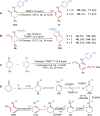Dehydrogenative synthesis of N-functionalized 2-aminophenols from cyclohexanones and amines: Molecular complexities via one-shot assembly
- PMID: 38691610
- PMCID: PMC11062582
- DOI: 10.1126/sciadv.adn7656
Dehydrogenative synthesis of N-functionalized 2-aminophenols from cyclohexanones and amines: Molecular complexities via one-shot assembly
Abstract
Polyfunctionalized arenes are privileged structural motifs in both academic and industrial chemistry. Conventional methods for accessing this class of chemicals usually involve stepwise modification of phenyl rings, often necessitating expensive noble metal catalysts and suffering from low reactivity and selectivity when introducing multiple functionalities. We herein report dehydrogenative synthesis of N-functionalized 2-aminophenols from cyclohexanones and amines. The developed reaction system enables incorporating amino and hydroxyl groups into aromatic rings in a one-shot fashion, which simplifies polyfunctionalized 2-aminophenol synthesis by circumventing issues associated with traditional arene modifications. The wide substrate scope and excellent functional group tolerance are exemplified by late-stage modification of complex natural products and pharmaceuticals that are unattainable by existing methods. This dehydrogenative protocol benefits from using 2,2,6,6-tetramethylpiperidine 1-oxyl (TEMPO) as oxidant that offers interesting chemo- and regio-selective oxidation processes. More notably, the essential role of in situ generated water is disclosed, which protects aliphatic amine moieties from overoxidation via hydrogen bond-enabled interaction.
Figures





Similar articles
-
A Tandem Dehydrogenation-Driven Cross-Coupling between Cyclohexanones and Primary Amines for Construction of Benzoxazoles.Angew Chem Int Ed Engl. 2022 Jul 25;61(30):e202203365. doi: 10.1002/anie.202203365. Epub 2022 Jun 7. Angew Chem Int Ed Engl. 2022. PMID: 35546303
-
A photochemical dehydrogenative strategy for aniline synthesis.Nature. 2020 Aug;584(7819):75-81. doi: 10.1038/s41586-020-2539-7. Epub 2020 Aug 5. Nature. 2020. PMID: 32760044
-
Electrochemical Cross-Dehydrogenative Aromatization Protocol for the Synthesis of Aromatic Amines.Org Lett. 2022 Feb 4;24(4):1011-1016. doi: 10.1021/acs.orglett.1c04129. Epub 2022 Jan 21. Org Lett. 2022. PMID: 35057623
-
Catalytic reductive aminations using molecular hydrogen for synthesis of different kinds of amines.Chem Soc Rev. 2020 Sep 7;49(17):6273-6328. doi: 10.1039/c9cs00286c. Epub 2020 Jul 30. Chem Soc Rev. 2020. PMID: 32729851 Review.
-
Recent advances in the transition metal-free oxidative dehydrogenative aromatization of cyclohexanones.Org Biomol Chem. 2021 Jul 28;19(29):6380-6391. doi: 10.1039/d1ob00908g. Org Biomol Chem. 2021. PMID: 34212968 Review.
References
-
- S. C. Mitchell, R. H. Waring, “[Aminophenols]” in Ullmann’s Encyclopedia of Industrial Chemistry, (Wiley-VCH, 2011), pp.1–20.
-
- Schmidt A. W., Reddy K. R., Knolker H. J., Occurrence, biogenesis, and synthesis of biologically active carbazole alkaloids. Chem. Rev. 112, 3193–3328 (2012). - PubMed
-
- Fu Y., Wang J., Zhao Q.-S., Wang X.-M., Xing Z.-Y., Ye F., Synthesis, crystal structure and biological activity of N-dichloroacetyl-3,4-dihydro-3-methyl-2H-1,4-benzoxazines. Indian J. Heterocy. CH. 24, 41–46 (2014).
-
- R. Tucceri, Poly(o-aminophenol) Film Electrodes: Synthesis, Transport Properties and Practical Applications, (Springer, Berlin, 2013).
LinkOut - more resources
Full Text Sources

